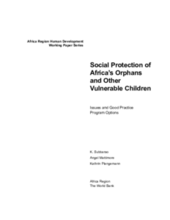AIDS and conflicts have orphaned millions of children on the African subcontinent. As a result, the problem of orphans and vulnerable children has reached catastrophic proportions in some countries. Given that the number of orphans is projected to treble over the next 10 years, it is tremendously important to address this problem and delineate the contours of public action.
True to the African tradition, the extended family and communities have risen to the occasion. For example, in Tanzania, grandparents are looking after 48 percent of orphans. In many countries, communities have shown remarkable resilience and creativity. The Uganda Women’s Efforts to Save Orphans is a good example of how communities are mobilizing to meet the crisis. Nongovernmental organizations (NGOs), bilateral donors, and international organizations such as the United Nations Children’s Fund (UNICEF) have also been active, often taking the lead in testing innovative solutions.
Nonetheless, serious strains on the traditional coping mechanisms are now evident. Although awareness of the plight of orphans is growing, no country has mounted the kind of response that is needed to match the severity of the crisis. The reasons include insufficient knowledge of the magnitude of the problem and the strength (or weaknesses) of existing coping strategies, lack of clarity on the advantages and disadvantages of possible interventions, limited capacity to implement interventions, and scarce resources. This paper aims to help fill the knowledge gap.
Before AIDS became rampant, approximately 2 percent of children in Africa were orphaned. That proportion has now reached 15–17 percent in some countries. The number of AIDS orphans, estimated at 12 million in 2000, is projected to increase to 35 million by 2010. In addition, the continent has a high number of orphans due to conflicts in as many as 16 countries, as well as numerous street children.
The impact of the orphan crisis is being felt in several areas. Preliminary evidence points to a worsening of educational outcomes and nutritional status of orphaned children. For example, recent crosscountry data assembled by UNICEF show that children who have lost both parents are less likely to be in school than are non-orphans. Research in Tanzania has shown that maternal orphans and children in households with recent adult deaths have delayed primary school enrollment (Ainsworth, Beegle, and Koda 2000). The research also indicates that the loss of either parent and the deaths of other bread-winning adults will worsen the stunting of children. While firm quantitative evidence on “who is bearing the burden of orphans” is unavailable, a recent participatory assessment in Zambia has shown that the bulk of the burden is falling on relatively poor households. Public response to the crisis has been slow in coming, though in some countries governments are preparing enhanced social protection programs for orphans. In Zimbabwe, the government is coordinating the efforts of multiple actors; it has also planned special interventions for orphans with the help of the World Bank and other donors. In Eritrea, the Bank is supporting a largescale effort to assist orphans through the Eritrea Integrated Early Childhood Development Project. The Zambia Investment Fund has recently developed a program for children in difficult circumstances, including orphans. In Botswana, the National Orphan Programme was established in 1999 and is run in partnership with government departments, NGOs, community-based organizations, and the private sector. There are also many NGOs working with orphans, especially in Uganda and Burundi, where they have played a leading role in addressing the plight of orphans.
This paper reviews these and other initiatives of governments, NGOs, and the World Bank, with a view toward delineating good practices. Designing and implementing appropriate interventions to protect orphans in Africa is a daunting task. This paper examines some of the issues in program design, especially those bearing on targeting. It also assesses the advantages, disadvantages, and costeffectiveness of various program interventions, including education and health subsidies, fostering, orphanages, and children’s villages.
©The World Bank

